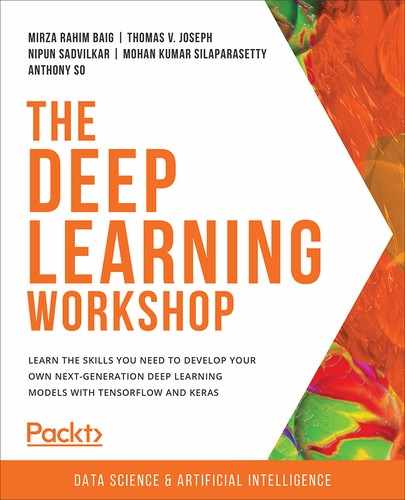Book Description
Take a hands-on approach to understanding deep learning and build smart applications that can recognize images and interpret text
Key Features
- Understand how to implement deep learning with TensorFlow and Keras
- Learn the fundamentals of computer vision and image recognition
- Study the architecture of different neural networks
Book Description
Are you fascinated by how deep learning powers intelligent applications such as self-driving cars, virtual assistants, facial recognition devices, and chatbots to process data and solve complex problems? Whether you are familiar with machine learning or are new to this domain, The Deep Learning Workshop will make it easy for you to understand deep learning with the help of interesting examples and exercises throughout.
The book starts by highlighting the relationship between deep learning, machine learning, and artificial intelligence and helps you get comfortable with the TensorFlow 2.0 programming structure using hands-on exercises. You'll understand neural networks, the structure of a perceptron, and how to use TensorFlow to create and train models. The book will then let you explore the fundamentals of computer vision by performing image recognition exercises with convolutional neural networks (CNNs) using Keras. As you advance, you'll be able to make your model more powerful by implementing text embedding and sequencing the data using popular deep learning solutions. Finally, you'll get to grips with bidirectional recurrent neural networks (RNNs) and build generative adversarial networks (GANs) for image synthesis.
By the end of this deep learning book, you'll have learned the skills essential for building deep learning models with TensorFlow and Keras.
What you will learn
- Understand how deep learning, machine learning, and artificial intelligence are different
- Develop multilayer deep neural networks with TensorFlow
- Implement deep neural networks for multiclass classification using Keras
- Train CNN models for image recognition
- Handle sequence data and use it in conjunction with RNNs
- Build a GAN to generate high-quality synthesized images
Who this book is for
If you are interested in machine learning and want to create and train deep learning models using TensorFlow and Keras, this workshop is for you. A solid understanding of Python and its packages, along with basic machine learning concepts, will help you to learn the topics quickly.
Table of Contents
- The Deep Learning Workshop
- Preface
- 1. Building Blocks of Deep Learning
- Introduction
- Introduction to TensorFlow
- Constants
- Variables
- Exercise 1.02: Implementing a Mathematical Equation
- Linear Algebra with TensorFlow
- Exercise 1.03: Matrix Multiplication Using TensorFlow
- The reshape Function
- Exercise 1.04: Reshaping Matrices Using the reshape() Function in TensorFlow
- The argmax Function
- Exercise 1.05: Implementing the argmax() Function
- Optimizers
- Exercise 1.06: Using an Optimizer for a Simple Linear Regression
- Activity 1.01: Solving a Quadratic Equation Using an Optimizer
- Summary
- 2. Neural Networks
- 3. Image Classification with Convolutional Neural Networks (CNNs)
- 4. Deep Learning for Text – Embeddings
- Introduction
- Deep Learning for Natural Language Processing
- Getting Started with Text Data Handling
- Text Preprocessing
- Exercise 4.01: Tokenizing, Case Normalization, Punctuation, and Stop Word Removal
- Stemming and Lemmatization
- Exercise 4.02: Stemming Our Data
- Activity 4.01: Text Preprocessing of the 'Alice in Wonderland' Text
- Text Representation Considerations
- Classical Approaches to Text Representation
- Distributed Representation for Text
- Word Embeddings and Word Vectors
- Training Our Own Word Embeddings
- Semantic Regularities in Word Embeddings
- Exercise 4.05: Vectors for Phrases
- Skip-gram versus CBOW
- Exercise 4.06: Training Word Vectors on Different Datasets
- Using Pre-Trained Word Vectors
- Bias in Embeddings – A Word of Caution
- Other Notable Approaches to Word Embeddings
- Activity 4.02: Text Representation for Alice in Wonderland
- Summary
- 5. Deep Learning for Sequences
- Introduction
- Working with Sequences
- Recurrent Neural Networks
- Loops – An Integral Part of RNNs
- Exercise 5.02: Implementing the Forward Pass of a Simple RNN Using TensorFlow
- The Flexibility and Versatility of RNNs
- Preparing the Data for Stock Price Prediction
- Parameters in an RNN
- Training RNNs
- Exercise 5.03: Building Our First Plain RNN Model
- Model Training and Performance Evaluation
- 1D Convolutions for Sequence Processing
- Exercise 5.04: Building a 1D Convolution-Based Model
- Performance of 1D Convnets
- Using 1D Convnets with RNNs
- Exercise 5.05: Building a Hybrid (1D Convolution and RNN) Model
- Activity 5.01: Using a Plain RNN Model to Predict IBM Stock Prices
- Summary
- 6. LSTMs, GRUs, and Advanced RNNs
- Introduction
- Long-Range Dependence/Influence
- The Vanishing Gradient Problem
- Sequence Models for Text Classification
- The Embedding Layer
- Building the Plain RNN Model
- Making Predictions on Unseen Data
- LSTMs, GRUs, and Other Variants
- Parameters in an LSTM
- LSTM versus Plain RNNs
- Gated Recurrence Units
- Bidirectional RNNs
- Stacked RNNs
- Summarizing All the Models
- Attention Models
- More Variants of RNNs
- Summary
- 7. Generative Adversarial Networks
- Introduction
- Key Components of Generative Adversarial Networks
- Problem Statement – Generating a Distribution Similar to a Given Mathematical Function
- Process 1 – Generating Real Data from the Known Function
- Exercise 7.01: Generating a Data Distribution from a Known Function
- Process 2 – Creating a Basic Generative Network
- Building the Generative Network
- Sequential()
- Exercise 7.02: Building a Generative Network
- Setting the Stage for the Discriminator Network
- Process 3 – Discriminator Network
- Exercise 7.03: Implementing the Discriminator Network
- Process 4 – Implementing the GAN
- Process for Building the GAN
- The Training Process
- Exercise 7.04: Implementing the GAN
- Deep Convolutional GANs
- Summary
- Introduction
- Appendix
